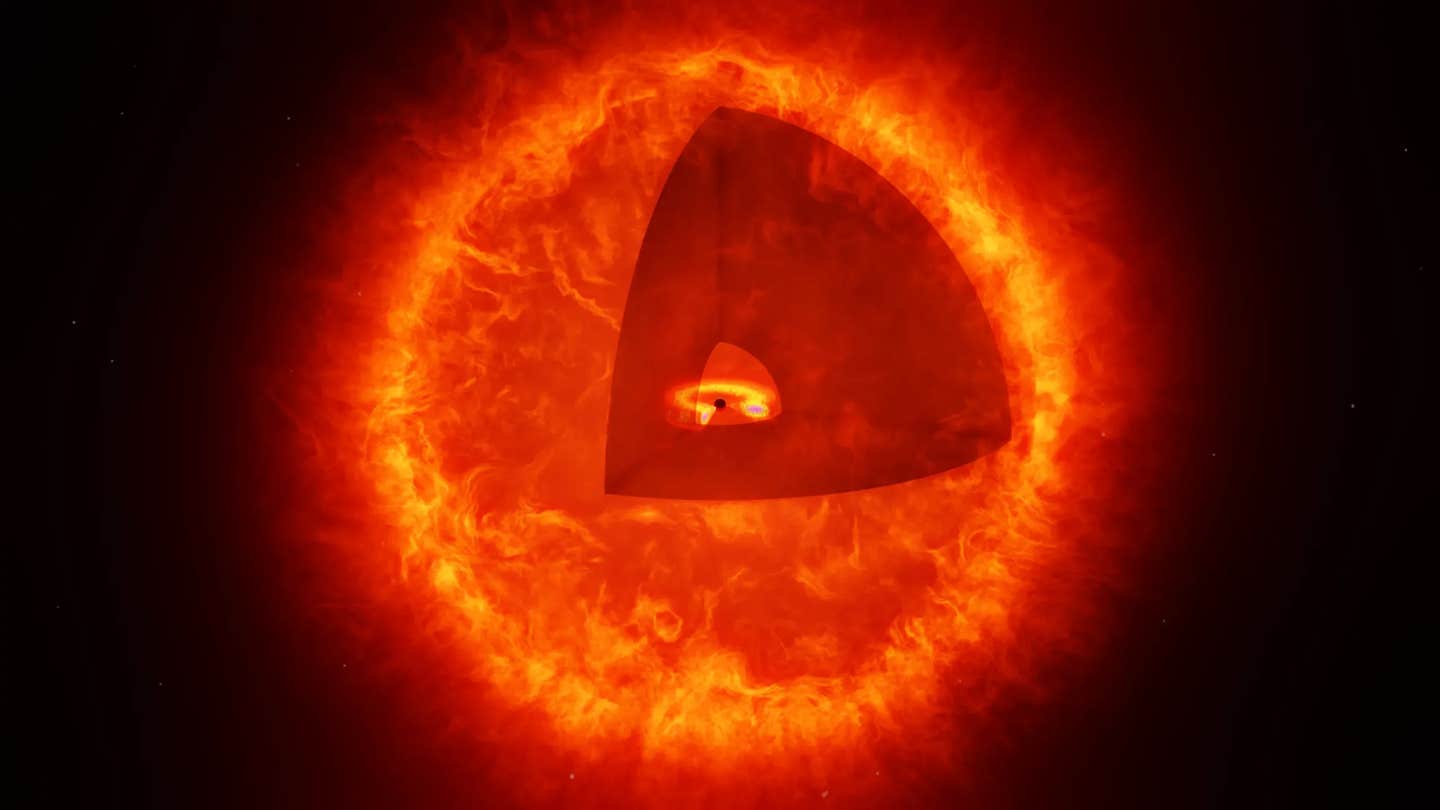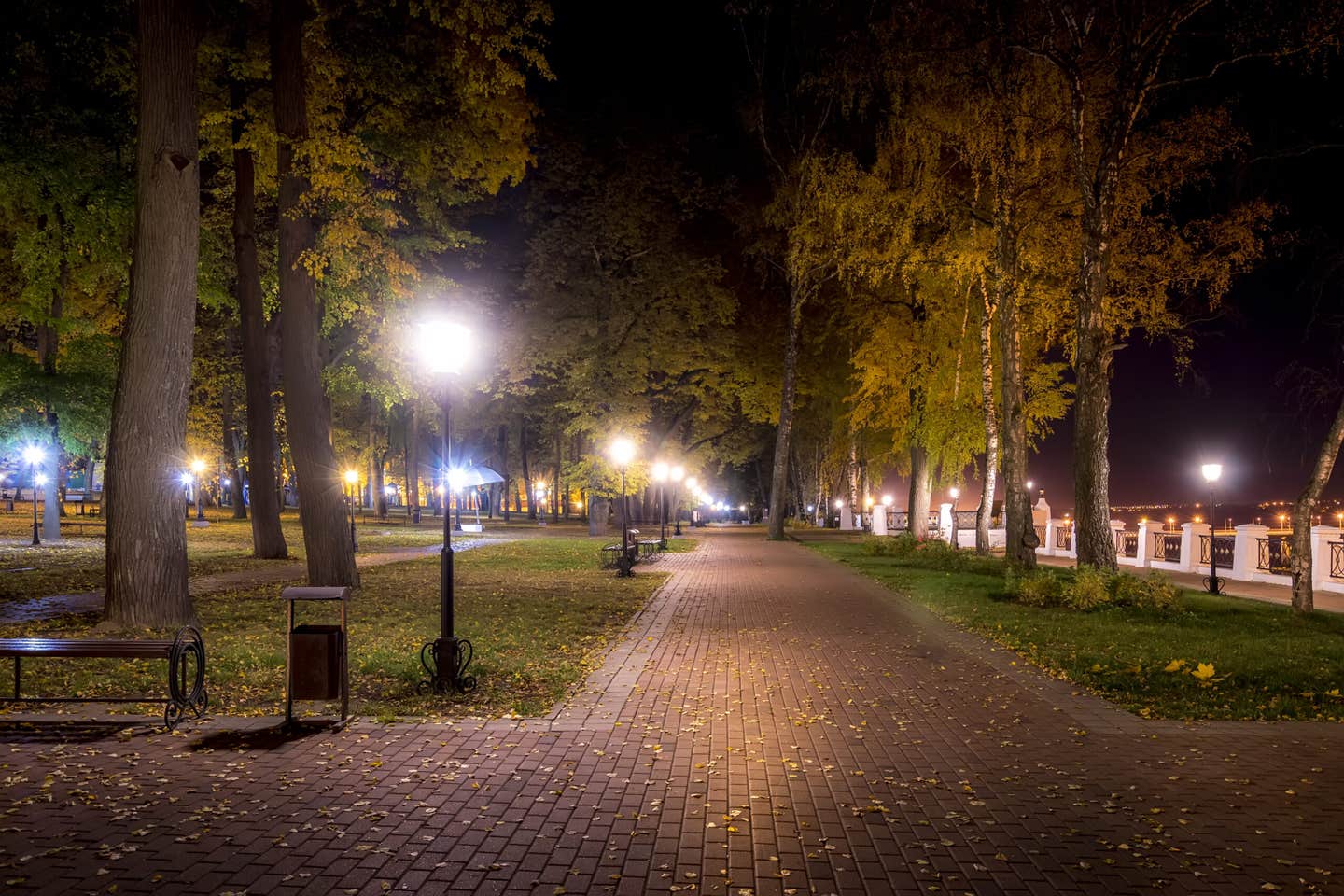Black hole stars: Giant stars may hide black holes at their core
Webb’s “little red dots” may be black holes in thick gas shells. The Cliff’s sharp spectrum pushes a bold new model.

Artist’s impression of a black hole star (not to scale). The cut-out reveals the central black hole with it surrounding accretion disk. (CREDIT: MPIA/HdA/T. Müller/A. de Graaff)
New data from the James Webb Space Telescope may solve a riddle from the universe’s beginnings. A compact, distant object called “The Cliff” appears to show that many of the mysterious “little red dots” found by Webb are not tiny, ancient galaxies after all. They may be supermassive black holes wrapped in a thick sheath of hot hydrogen gas. The team behind the finding calls this new class a “black hole star,” or BH*.
The dots that didn’t fit the script
In mid-2022, less than a month after Webb began science work, astronomers noticed scores of tiny crimson pinpricks in infrared images. These sources glowed at wavelengths beyond a ten-millionth of a meter, squarely in Webb’s wheelhouse but far past Hubble’s reach. Even the nearest samples sit so far away that their light has traveled about 12 billion years, letting you see them as they were only 1.8 billion years after the Big Bang.
At first, many scientists read the dots as dust-choked galaxies jammed with stars. That idea created a headache. Packing several hundred thousand stars into a cube just a light-year on a side would make them far denser than any region in the Milky Way, even its nucleus. The required stellar masses—up to hundreds of billions of suns so early in cosmic history—strained models of how fast galaxies can grow.
“The night sky of such a galaxy would be dazzlingly bright,” said Bingjie Wang of Penn State University. “If this interpretation holds, it implies that stars formed through extraordinary processes which have never been observed before.”
Others argued the dots were active galactic nuclei, the blazing cores of galaxies where matter swirls into a central black hole. But that explanation also struggled. The spectra looked off compared with known dust-reddened AGN, and the implied black hole masses, multiplied across many objects, felt too steep.
A survey finds the sharpest “cliff” yet
To break the stalemate, an international collaboration led by Anna de Graaff at the Max Planck Institute for Astronomy secured nearly 60 hours of Webb observing time. The RUBIES program—short for Red Unknowns: Bright Infrared Extragalactic Survey—captured spectra for 4,500 remote galaxies during 2024 and flagged 35 little red dots for close study. Among them sat a standout.
In July 2024, the team found an extreme source at redshift z = 3.55, which you see as it looked 11.9 billion years ago. Its nickname came easy: The Cliff.
The Cliff’s spectrum shows a dramatic Balmer break, a steep rise in brightness across a boundary set by hydrogen atoms. Over vast cosmic time, the universe’s expansion stretched that ultraviolet feature into the near-infrared light that Webb records. Astronomers do see Balmer breaks in galaxies where star birth has slowed, and in individual hot stars. Yet The Cliff’s break is far steeper than any ordinary galaxy can explain.
Models that miss and one that matches
De Graaff’s team tried everything standard. They built and tested galaxy models with extreme star formation, outsized dust loads, and unusual stellar birth patterns. They also explored AGN templates dimmed by dust. None could reproduce The Cliff’s sharp break and overall shape. “The extreme properties of The Cliff forced us to go back to the drawing board, and come up with entirely new models,” de Graaff said.
One clue stood out. The Cliff’s spectrum looks more like a single star’s atmosphere than the blended light of a whole galaxy. That hint led the team to the BH* idea: a feeding supermassive black hole and accretion disk, cocooned inside a dense, turbulent sphere of hydrogen gas. In this picture, the black hole’s radiation heats the envelope much as a star’s core warms its outer layers. You do not get nuclear fusion at the center. You do get a star-like skin that shapes the light.
When the team applied this gas-enveloped AGN model, the fit improved sharply. The thick hydrogen layer both reddens the continuum and sculpts a cliff-like Balmer break. The result matches The Cliff’s spectrum far better than galaxy-only or dust-only AGN options.
As the authors write, “We … conclude that the rest-optical and near-infrared continuum of The Cliff cannot originate from a massive, evolved stellar population with an extremely high stellar density. Instead, we argue that the most plausible model is that of a luminous ionizing source reddened by dense, absorbing gas in its close vicinity. Currently, the only model capable of producing both the strength and shape of the observed Balmer break is that of a black hole star.”
Stress-testing the dense galaxy idea
Independent checks also undercut the extreme-galaxy scenario. Best-fit stellar models demanded about 10^10.5 solar masses packed into a region only ~40 parsecs wide. At that density, stars would smack into each other often.
The team estimated collision rates from one to six per year, thousands of times above rates near the Milky Way’s central black hole. Such crashes, or a fast star plowing through a giant’s outer layers, should heat gas to tens of millions of degrees and light up the X-ray sky. Telescopes do not see those X-rays from The Cliff.
Webb’s spectra also reveal broad hydrogen emission—Hα with a full width at half maximum of roughly 1,500 kilometers per second—and helium emission, but few metal lines. A mature stellar population should leave metal fingerprints. Their absence fits a powerful ionizing engine wrapped in relatively simple hydrogen gas rather than a crowded star city.
Not dust alone, and not business as usual
Crucially, the red color does not appear to come from dust alone. The data favor an intrinsically redder continuum, consistent with thick gas reshaping the light from a central engine. That engine could be a black hole gobbling matter at super-Eddington rates, faster than standard physics once allowed. If so, BH* systems may help explain how billion-solar-mass black holes emerged within the first billion years.
The team stresses that BH* is a working model, not a final verdict. It blends black hole physics and atmospheric radiative transfer in a new way, and today’s fits are proofs of concept. Still, The Cliff offers a rare, tight test.
“The Cliff presents the strongest direct evidence to date that the Balmer break and rest optical to near-infrared spectral energy distribution in LRDs can be dominated by emission from an active galactic nucleus, rather than evolved stellar populations, although many open questions regarding the black hole and host galaxy properties remain,” the researchers write.
What it means for early galaxy growth
If BH* objects are common among little red dots, then your picture of early galaxy building must shift. Many of the faint red sources near cosmic dawn may be black hole-powered systems, not ultra-dense star factories. That change eases the tension with galaxy formation timelines and reframes how mass assembled in the first few billion years. It also offers a fresh path for rapid black hole growth, with dense gas both feeding and hiding the core.
The results have been accepted for publication in Astronomy & Astrophysics. The analysis led by de Graaff focuses on The Cliff and the BH* model. A companion study led by Raphael E. Hviding presents the full sample of little red dots in the RUBIES data. The broader team includes researchers from the Max Planck Institute for Astronomy, the Cosmic Dawn Center, Princeton University, Swinburne University, MIT, and Penn State University.
What comes next
Approved follow-up Webb observations will target The Cliff and other top candidates next year. Deeper spectra across wider wavelength ranges, paired with sensitive X-ray limits, should test the BH* model’s predictions. Key questions remain. How do such gas envelopes form and stay bound while a black hole feeds? What mechanism refuels the shroud as the core consumes it? And how does starlight from the host galaxy mix with the BH* glow across the population of little red dots?
For now, The Cliff stands as a benchmark. Its sharp spectral edge, broad hydrogen lines, and sparse metal features point to a hidden engine at work. The cosmos, it turns out, still loves a plot twist.
Recasting little red dots as black hole–driven systems reduces the need for impossible early star factories. That shift tightens galaxy evolution models and guides where you point scarce observing time.
The BH* idea offers a concrete path for rapid black hole growth, which helps explain the giant black holes that anchor today’s galaxies. Better growth models improve simulations used across astrophysics, from reionization studies to feedback recipes that set star-formation rates.
The work also sharpens search strategies for the first luminous structures, helping future missions map the timeline of light in the universe.
Related Stories
- A wormhole from another universe? Scientists revisit the puzzling black hole GW190521
- Runaway black hole defies growth limit, expands at record rate
- Scientists finally confirm Hawking’s black hole law strengthening Einstein’s theory of gravity
Like these kind of feel good stories? Get The Brighter Side of News' newsletter.
Joseph Shavit
Science News Writer, Editor-At-Large and Publisher
Joseph Shavit, based in Los Angeles, is a seasoned science journalist, editor and co-founder of The Brighter Side of News, where he transforms complex discoveries into clear, engaging stories for general readers. With experience at major media groups like Times Mirror and Tribune, he writes with both authority and curiosity. His work spans astronomy, physics, quantum mechanics, climate change, artificial intelligence, health, and medicine. Known for linking breakthroughs to real-world markets, he highlights how research transitions into products and industries that shape daily life.



